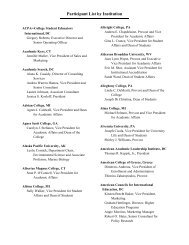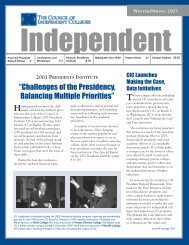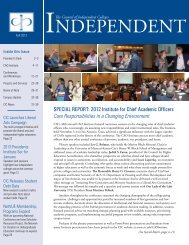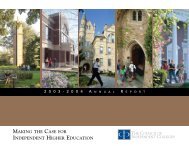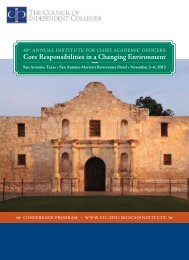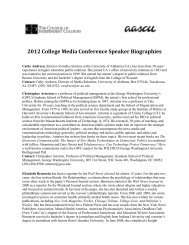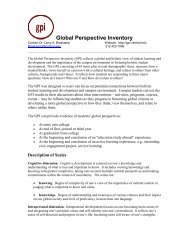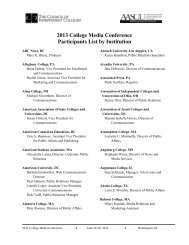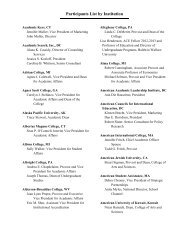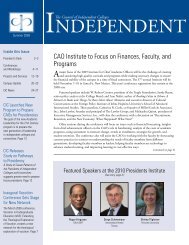Annual Report 2006-2007 - The Council of Independent Colleges
Annual Report 2006-2007 - The Council of Independent Colleges
Annual Report 2006-2007 - The Council of Independent Colleges
You also want an ePaper? Increase the reach of your titles
YUMPU automatically turns print PDFs into web optimized ePapers that Google loves.
Connecting Leaders<br />
CIC provides opportunities—through conferences, meetings,<br />
confidential consultations, and listservs—for campus leaders to<br />
share ideas and learn from one another. Among these programs and<br />
services are the following:<br />
Programs for Presidents<br />
Presidents Institute—CIC’s <strong>2007</strong> Institute<br />
provided presidents with new ideas, leadership<br />
enhancement strategies, and networking<br />
opportunities. <strong>The</strong> Institute, held in Tucson,<br />
Arizona, under the theme <strong>of</strong> “<strong>The</strong> Anticipatory<br />
Presidency and the 21st Century Campus,”<br />
attracted 288 presidents and 173 spouses<br />
and garnered another record level <strong>of</strong> support<br />
from sponsors.<br />
Plenary speakers included George Rupp, president <strong>of</strong> the<br />
International Rescue Committee in New York, who keynoted the<br />
Institute with a poignant speech on the challenge <strong>of</strong> American<br />
provincialism; Rita Colwell, distinguished pr<strong>of</strong>essor at the University<br />
<strong>of</strong> Maryland, College Park, and former director <strong>of</strong> the National<br />
Science Foundation, who discussed the under-representation <strong>of</strong><br />
women and minorities in the sciences and the need for investment<br />
in basic research; Michael Dolence, president <strong>of</strong> Michael G. Dolence<br />
& Associates, who addressed the importance <strong>of</strong> curricular reform in<br />
staying globally competitive; and a closing panel (see box) <strong>of</strong> current<br />
and former presidents who explored critical issues in higher education<br />
finance, pricing, and discounting that institutions will face in the<br />
coming decade.<br />
Presidential Vocation and Institutional Mission—CIC entered a third<br />
successful year <strong>of</strong> its Presidential Vocation and Institutional Mission<br />
program, a distinctive series <strong>of</strong> seminars for presidents, as well as<br />
prospective presidents, that center on the idea <strong>of</strong> vocation, the character<br />
<strong>of</strong> educational communities, and the relationship <strong>of</strong> faith and reason.<br />
This year’s program focused on prospective presidents, assisting them<br />
in reflecting on their sense <strong>of</strong> calling as it relates to the missions <strong>of</strong> the<br />
<strong>2007</strong> Presidents Institute Address<br />
“<strong>The</strong> Economic Future <strong>of</strong> <strong>Independent</strong> Higher Education:<br />
Problems and Solutions”<br />
At the <strong>2007</strong> Presidents Institute, a closing panel <strong>of</strong> current and former<br />
presidents—James L. Doti <strong>of</strong> Chapman University (CA), Morton Owen<br />
Schapiro <strong>of</strong> Williams College (MA), and Michael S. McPherson <strong>of</strong> the<br />
Spencer Foundation—predicted severe challenges for higher education in<br />
the next decade. In forecasting the economic future <strong>of</strong> higher education,<br />
the panel emphasized that colleges and universities will likely see<br />
continued strategic use <strong>of</strong> tuition discounting, particularly at highly selective<br />
institutions; increasingly constrained federal and state funding for higher<br />
education as a result <strong>of</strong> the nation’s ballooning budget deficit; and major<br />
demographic and regional changes in the demand for higher education.<br />
<strong>The</strong> panel—drawing on their research on campus demographics and the<br />
economics <strong>of</strong> higher education—<strong>of</strong>fered future projections such as:<br />
• <strong>The</strong> proportion <strong>of</strong> white students at colleges and universities will<br />
decrease from 74 percent today to less than 60 percent in 2020;<br />
the proportion <strong>of</strong> Hispanic applicants is predicted to double from 6<br />
percent to 12 percent; and the differences by region will be striking—<br />
many more students will come from the Sunbelt states and fewer will<br />
come from New England and the Midwest.<br />
• Charging a higher tuition price and <strong>of</strong>fering discounts can have a<br />
positive impact on enrollment, but mainly for the highly selective<br />
institutions. Analysis suggests that high-selectivity schools retained 57<br />
cents for every dollar they spent on tuition discounting; low-selectivity<br />
institutions retained only 35 cents per dollar. <strong>The</strong>refore, less selective<br />
institutions are not as able to use effectively a high-tuition, highdiscount<br />
policy.<br />
• <strong>The</strong> predicted $3.5 trillion federal budget deficit means that finding<br />
money to fund higher education will be a struggle. <strong>The</strong>re may be<br />
a long-term decline in the governmental priority given to higher<br />
education spending, resulting in federal regulation and insistence on<br />
assessment. To counter this shift, presidents will need to tell <strong>of</strong>ficials<br />
what colleges and universities are already doing to assess educational<br />
effectiveness in order to foster a “culture <strong>of</strong> evidence” on campus.<br />
Drew University, NJ<br />
<strong>2006</strong>–<strong>2007</strong> <strong>Annual</strong> <strong>Report</strong> •



